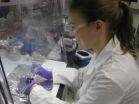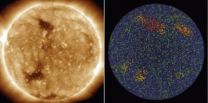(Press-News.org) AURORA, Colo. (April 17, 2014) – Two recent papers by a University of Colorado School of Medicine researcher and colleagues may help scientists develop treatments or vaccines for Dengue fever, West Nile virus, Yellow fever, Japanese encephalitis and other disease-causing flaviviruses.
Jeffrey S. Kieft, PhD, associate professor of biochemistry and molecular genetics at the School of Medicine and an early career scientist with the Howard Hughes Medical Institute, and colleagues recently published articles in the scholarly journals eLife and Science that explain how flaviviruses produce a unique RNA molecule that leads to disease.
More than 40 percent of people around the world are at risk of being bitten by mosquitoes infected with the virus that causes Dengue fever and more than 100 million people are infected, according to eLife. Many develop headaches, pain and fever, but some develop a life-threatening condition where tiny blood vessels in the body begin to leak. Other flaviviruses, such as West Nile virus, are rapidly spreading around the globe. Flaviviruses are considered dangerous emerging pathogens.
The eLife paper shows that the virus causing Dengue fever and other closely related viruses like West Nile and Japanese encephalitis use instructions encoded on a single strand of RNA to take over an infected cell and reproduce. The viruses also exploit an enzyme that cells use to destroy RNA to instead produce short stretches of RNA that, among other things, may help the virus avoid the immune system of its host. Ironically, these viruses use a structured RNA molecule to resist an enzyme that normally "chews up" RNA.
The Science paper reveals the discovery that the resistant RNA folds up into an unprecedented "knot-like" structure. The enzyme, normally adept at breaking up RNA structure, encounters this particular structured RNA and cannot "untangle" it; thus the enzyme is thwarted. This is the first time this sort of RNA structure has been observed and it has characteristics that may be amenable to targeting by new drugs. To discover this structure, the researchers used a technique called x-ray crystallography, which allowed them to determine the structures of individual molecules.
This understanding of how an RNA found in many different flaviviruses thwarts a powerful enzyme may help scientists develop treatments or vaccines.
INFORMATION:
Kieft is the corresponding author of the eLife aticle. The other authors are Erich G. Chapman, PhD, Stephanie L. Moon and Jeffrey Wilusz, PhD, professor of microbiology, immunology and pathology at Colorado State University. Kieft is also the corresponding author of the Science aticle. The other authors on the Science article are Chapman, David A. Costantino, MS, Jay C. Nix, PhD, Moon, and Wilusz. Funding was provided by the Howard Hughes Medical Institute and the National Institutes of Health
Faculty at the University of Colorado School of Medicine work to advance science and improve care. These faculty members include physicians, educators and scientists at University of Colorado Hospital, Children's Hospital Colorado, Denver Health, National Jewish Health, and the Denver Veterans Affairs Medical Center. The school is located on the Anschutz Medical Campus, one of four campuses in the University of Colorado system. To learn more about the medical school's care, education, research and community engagement, visit its web site.
CU researchers discover target for treating dengue fever
2014-04-17
ELSE PRESS RELEASES FROM THIS DATE:
Vitamin B3 might have been made in space, delivered to Earth by meteorites
2014-04-17
Ancient Earth might have had an extraterrestrial supply of vitamin B3 delivered by carbon-rich meteorites, according to a new analysis by NASA-funded researchers. The result supports a theory that the origin of life may have been assisted by a supply of key molecules created in space and brought to Earth by comet and meteor impacts.
"It is always difficult to put a value on the connection between meteorites and the origin of life; for example, earlier work has shown that vitamin B3 could have been produced non-biologically on ancient Earth, but it's possible that an added ...
Bright points in sun's atmosphere mark patterns deep in its interior
2014-04-17
Like a balloon bobbing along in the air while tied to a child's hand, a tracer has been found in the sun's atmosphere to help track the flow of material coursing underneath the sun's surface.
New research that uses data from NASA's Solar Dynamics Observatory, or SDO, to track bright points in the solar atmosphere and magnetic signatures on the sun's surface offers a way to probe the star's depths faster than ever before. The technique opens the door for near real-time mapping of the sun's roiling interior – movement that affects a wide range of events on the sun from ...
Lab researcher discovers the green in Greenland
2014-04-17
At one point in history, Greenland was actually green and not a country covered in ice.
An international team of researchers, including a scientist from Lawrence Livermore National Laboratory, has discovered that ancient dirt in Greenland was cryogenically frozen for millions of years under nearly two miles of ice.
More than 2.5 million years ago. Greenland looked like the green Alaskan tundra, before it was covered by the second largest body of ice on Earth.
The ancient dirt under the Greenland ice sheet helps to unravel an important mystery surrounding climate change: ...
Multitarget TB drug could treat other diseases, evade resistance
2014-04-17
CHAMPAIGN, Ill. — A drug under clinical trials to treat tuberculosis could be the basis for a class of broad-spectrum drugs that act against various bacteria, fungal infections and parasites, yet evade resistance, according to a study by University of Illinois chemists and collaborators.
Led by U. of I. chemistry professor Eric Oldfield, the team determined the different ways the drug SQ109 attacks the tuberculosis bacterium, how the drug can be tweaked to target other pathogens from yeast to malaria – and how targeting multiple pathways reduces the probability of pathogens ...
Study recalculates costs of combination vaccines
2014-04-17
CHAMPAIGN, Ill. — One of the most popular vaccine brands for children may not be the most cost-effective choice. And doctors may be overlooking some cost factors when choosing vaccines, driving the market toward what is actually a more expensive option, according to a new study by University of Illinois researchers.
"The choice of vaccines to administer can be driven by numerous factors," says Sheldon H. Jacobson, a co-author of the study and a professor of computer science and of mathematics at the U. of I. "In an environment where vaccines are under growing public scrutiny, ...
Feinstein Institute researcher publishes new perspective on sepsis
2014-04-17
MANHASSET, NY – In a review published in the April issue of Immunity, Kevin J. Tracey, MD, president of The Feinstein Institute for Medical Research, says it's time to take a fresh look at the medical community's approach to treating sepsis, which kills millions worldwide every year, including more than 200,000 Americans.
Sepsis occurs when molecules released into the bloodstream to fight an injury or infection trigger inflammation throughout the body. Inflammation is necessary for maintaining good health – without inflammation, wounds and infections would never be ...
McCullers reviews influenza, bacterial superinfections in Nature Reviews Microbiology
2014-04-17
Le Bonheur Children's Hospital Pediatrician-in-Chief Jon McCullers, MD, was recently invited to submit a review in the April issue of Nature Reviews Microbiology, one of the world's foremost scientific publications. Dr. McCullers, a world-renowned infectious disease specialist, and chair of the Department of Pediatrics at the University of Tennessee Health Science Center, analyzed the epidemiology and microbiology of co-infections during the 1918, 1957 and 1968 pandemics, as well as more recent 2009 novel H1N1 pandemic.
He reviewed the co-pathogenesis of influenza viruses ...
Building 'smart' cell-based therapies
2014-04-17
A Northwestern University synthetic biology team has created a new technology for modifying human cells to create programmable therapeutics that could travel the body and selectively target cancer and other sites of disease.
Engineering cell-based, biological devices that monitor and modify human physiology is a promising frontier in clinical synthetic biology. However, no existing technology enabled bioengineers to build such devices that sense a patient's physiological state and respond in a customized fashion.
"The project addressed a key gap in the synthetic biology ...
Live cell imaging reveals distinct alterations of subcellular glutathione potentials
2014-04-17
In the April issue of Experimental Biology and Medicine a multidisciplinary research team led by Drs. Rex Gaskins and Paul Kenis in the Institute of Genomic Biology (IGB) on the campus of the University of Illinois Urbana-Champaign describe their recent work on subcellular redox homeostasis. Intracellular reduction-oxidation reactions underlie a variety of cell functions including energy metabolism, signaling, and transcriptional processes. Due to these crucial roles in regulating normal cellular behavior, redox status has been recognized as a key area of biological research ...
The ilk of human kindness
2014-04-17
Researchers at the University of California, San Diego School of Medicine report that older women, plucky individuals and those who have suffered a recent major loss are more likely to be compassionate toward strangers than other older adults.
The study is published in this month's issue of the International Journal of Geriatric Psychiatry.
Because compassionate behaviors are associated with better health and well-being as we age, the research findings offer insights into ways to improve the outcomes of individuals whose deficits in compassion put them at risk for becoming ...


